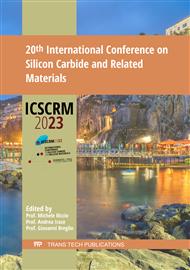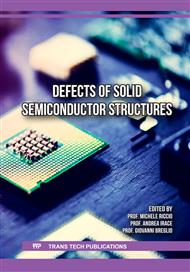p.1
p.7
p.15
p.23
p.33
p.39
p.45
p.51
Study on Quantification of Correlation between Current Density and UV Irradiation Intensity, Leading to Bar Shaped 1SSF Expansion
Abstract:
In 4H-SiC devices, the reliability issue of the bipolar degradation, which is caused by the nucleation and expansion of 1SSF (single Shockley stacking fault) defects originating from basal plane dislocations (BPDs), has not been completely eliminated. To avoid the reliability issue, in some device manufacturers is currently introduced so-called "burn-in" (accelerated current stress) screening operation, which is very time-consuming process which raises a total cost of production. While, the bipolar degradation is explained by the REDG (recombination-enhanced dislocation glide) mechanism, and the same degradation can be induced by UV (ultraviolet) irradiation. Using this property, we have been proposing a new screening method to detect latent defects with expanding to 1SSFs at an early stage of manufacturing. In order to bring this screening method to a practical level, it is essential to correlate the accelerated current stress with the UV irradiation quantitatively in terms of the effect of 1SSF expansion. We have attained some progress in an attempt to quantify this correlation and describe it in this paper.
Info:
Periodical:
Pages:
23-31
Citation:
Online since:
August 2024
Authors:
Permissions:
Share:
Citation:



